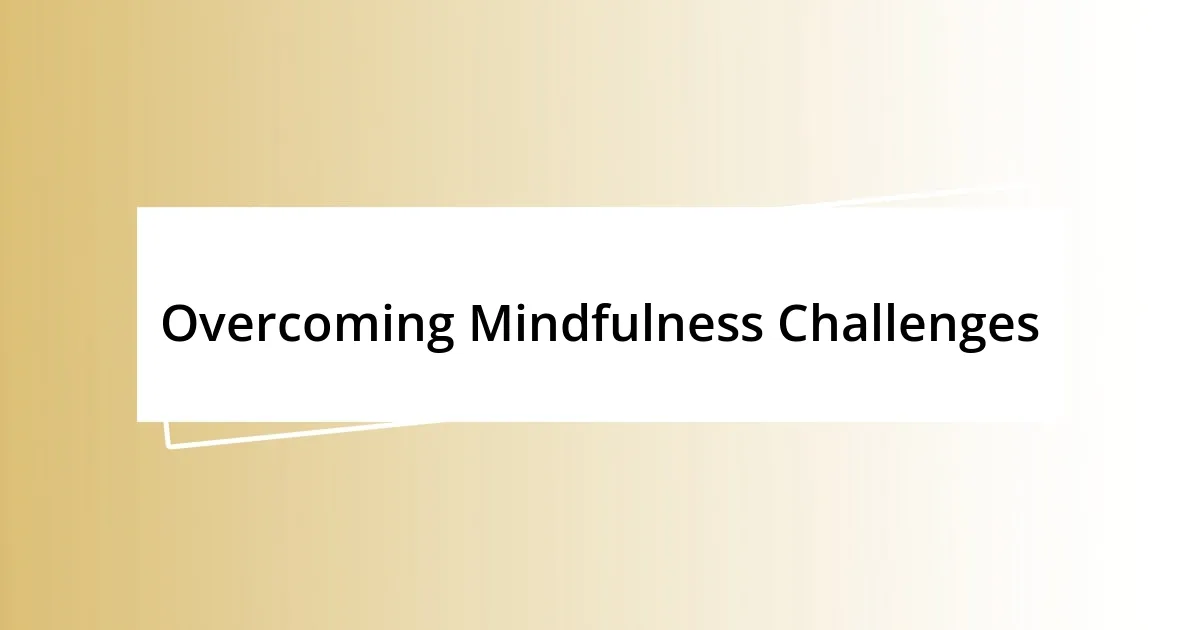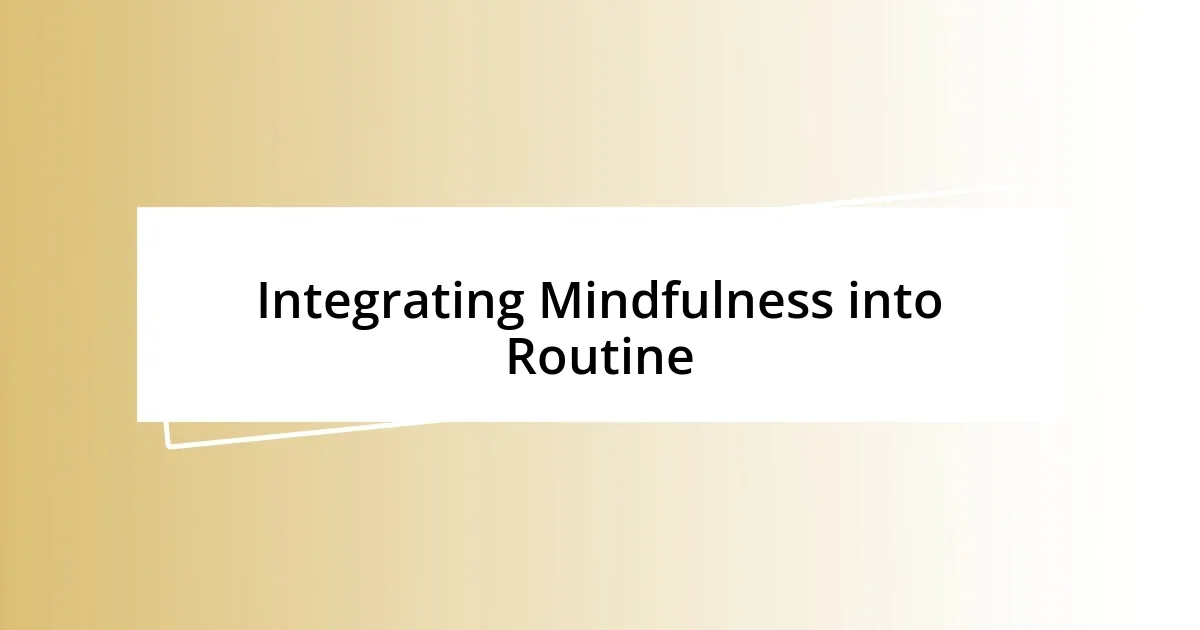Key takeaways:
- Mindfulness practices encourage being present and observing thoughts without judgment, transforming ordinary activities into meaningful experiences.
- Benefits of mindfulness include reduced stress, improved focus, enhanced emotional regulation, better relationships, and increased self-awareness.
- Practical exercises like the five-senses technique, mindful breathing, and gratitude journaling can easily be integrated into daily routines to cultivate mindfulness.
- Resources such as guided meditation apps, mindfulness books, and online communities can enhance the practice and provide support for mindfulness improvement.

Understanding Mindfulness Practices
Mindfulness practices center around the art of being present in the moment. I recall sitting in my backyard, feeling the warmth of the sun, and suddenly realizing how often I’d rush through life without truly experiencing it. Have you ever felt that disconnect?
At its core, mindfulness encourages us to observe our thoughts and feelings without judgment. I remember my first mindful meditation session; my mind raced, and I felt frustrated. However, over time, I learned that those distractions were part of the practice, illustrating our natural tendency to wander.
Engaging in mindfulness can transform mundane activities into profound experiences. The next time you’re washing dishes or going for a walk, try to focus entirely on the sensations and emotions those moments evoke. I find myself noticing the water’s warmth and the rhythm of my movements, making even the simplest tasks feel enriching. How often do we overlook the beauty in these everyday scenarios?

Benefits of Mindfulness Techniques
Practicing mindfulness offers a wealth of benefits that can enhance our daily lives. For instance, I remember when I first incorporated mindfulness into my morning routine. Instead of rushing through my coffee, I took a moment to savor each sip, which not only improved my mood but set a positive tone for the rest of my day. This experience exemplifies how mindfulness can promote a deeper connection to the present moment, improving overall well-being.
Here are some key benefits of mindfulness techniques:
– Reduced Stress: I often find that taking a few mindful breaths can shift my perspective in overwhelming situations.
– Improved Focus: During a work project, tuning into the task at hand helps me maintain clarity rather than getting distracted by a flurry of ideas.
– Enhanced Emotional Regulation: I’ve noticed that mindfulness practices make it easier to navigate my emotions, allowing me to respond thoughtfully rather than react impulsively.
– Better Relationships: Practicing mindfulness has helped me listen more attentively to others, fostering stronger connections with family and friends.
– Increased Self-Awareness: Each time I engage in reflection, I discover new insights about my patterns and behaviors, guiding me toward personal growth.

Daily Mindfulness Exercises
Daily mindfulness exercises can be simple yet profound ways to integrate mindfulness into your life. One exercise I enjoy is the “five-senses” technique, where I take a moment to identify five things I can see, four I can touch, three I can hear, two I can smell, and one I can taste. This practice grounds me, pulling my mind back to my surroundings and providing a comforting sense of stability.
Another effective exercise I’ve adopted is mindful breathing. I set aside just a few minutes each day to focus solely on my breath. Sometimes, I close my eyes to minimize distractions and take deep, intentional breaths. Surprisingly, this practice not only calms my racing thoughts but also gives me a refreshing lift of energy throughout the day.
Incorporating gratitude into my mindfulness practices has transformed my perspective. I keep a journal where each day, I note three things I’m grateful for. This simple act has shifted my focus from what’s lacking in my life to the abundance that already exists. Believe me, it’s enlightening how such a small change can create ripples of positivity in your mindset.
| Exercise | Description |
|---|---|
| Five-Senses Technique | Involves identifying five things each from your senses to ground yourself in the present moment. |
| Mindful Breathing | Taking a few minutes daily to focus solely on your breathing, promoting calmness and clarity. |
| Gratitude Journaling | Writing down three things you’re grateful for each day to shift your mindset towards positivity. |

Cultivating Mindfulness in Life
Cultivating mindfulness in our daily lives can seem daunting, but it doesn’t have to be. I’ll never forget the first time I decided to take my mindful moments outside of my usual practice. While walking in the park, I consciously focused on my surroundings—the rustle of the leaves, the warmth of the sun, the laughter of children nearby. This simple shift in awareness turned an ordinary stroll into a rich tapestry of experiences, reminding me how much beauty surrounds us if we just pay attention.
Another ingrained habit I’ve developed is mindful eating. The initial challenge of slowing down at mealtime was eye-opening. I remember bringing my lunch to work and intentionally taking small bites, truly tasting each flavor. The act of savoring my food not only nourished my body but also created a much-needed pause in my hectic day. Have you ever tried this? If you find it challenging, maybe start with just one meal a week to practice being present with each bite.
Even moments of transition can serve as opportunities to cultivate mindfulness. For instance, during my commute, instead of mindlessly scrolling through my phone, I take a few minutes to simply breathe and observe my thoughts. How often do we rush from one task to the next without stopping to acknowledge where we are? This practice has transformed my commutes from stressful races against time into calm reflections that prepare me for whatever lies ahead.

Overcoming Mindfulness Challenges
It’s not uncommon to struggle with mindfulness practices, especially when distractions abound. I remember a particularly chaotic week when I tried to meditate and found myself consumed by a whirlwind of thoughts. That experience really made me question if I was doing it “right.” Over time, I learned to embrace those distractions as part of my practice, reminding myself that each moment of chaos could be an opportunity to refocus and return to my breath.
One challenge that I often face is the overwhelming urge to judge myself during mindfulness exercises. For instance, while trying to engage in mindful breathing, I would sometimes catch myself thinking, “Am I even doing this correctly?” That self-doubt can be paralyzing. What I found helpful was allowing myself to simply be present and accept any thoughts or feelings that arose, treating them like passing clouds rather than obstacles. This shift in perspective has made practicing mindfulness feel more inviting and less intimidating.
Another hurdle can be establishing a consistent routine amidst life’s unpredictability. Just last month, I struggled to carve out time for my daily exercises. It felt disheartening, but I realized that rather than aiming for perfection, I could view mindfulness as a flexible companion. Some days, I squeezed in just a minute of mindful breathing during a busy lunch break instead of a dedicated session. Finding those small pockets of time transformed my approach. Have you tried incorporating mindfulness in snippets throughout your day? It’s surprising how such brief moments can weave mindfulness into the fabric of your life, one breath at a time.

Integrating Mindfulness into Routine
Integrating mindfulness into my daily routine has been a game changer. I remember when I first decided to treat my morning coffee not just as a caffeine fix, but as a mindful moment. Instead of gulping it down while scrolling through emails, I began to savor each sip, noticing the warmth of the cup in my hands and the rich aroma wafting up. This practice not only enhanced my enjoyment but also set a calm tone for the rest of my day. Have you ever tried slowing down during a ritual like this?
Another angle I’ve embraced recently is the idea of “mindful chores.” You might be surprised, but folding laundry has become a moment of meditation for me. As I sort through the fresh garments, I focus on the textures and colors, breathing in the scent of fabric softener. It’s fascinating how a mundane task can transform into a soothing experience. What if you dedicated just five minutes of cleaning to simply be present? It’s amazing how even a few moments can enrich an otherwise routine task.
Additionally, I’ve started to integrate mindfulness during unexpected pauses in my day. Whether I’m waiting for my computer to boot up or standing in line at the grocery store, I take a moment to observe my surroundings and breathe deeply. It might sound simple, but those minutes of awareness have created a sense of peace that permeates my day. Have you noticed those little gaps where mindfulness could slip in? It’s these small integrations that can make a big difference over time, turning everyday moments into mindful experiences.

Resources for Mindfulness Improvement
Finding reliable resources for mindfulness improvement has been a transformative part of my journey. I remember the first time I stumbled across an app dedicated to guided meditations. My initial skepticism quickly turned into appreciation as I explored various sessions tailored to different needs, like stress relief or focus enhancement. Have you ever tried guided meditation? It can bring a sense of direction, especially when starting out.
Books have also played a pivotal role in deepening my understanding of mindfulness. I can’t forget the impact that “The Miracle of Mindfulness” by Thich Nhat Hanh had on me. His gentle approach offered practical exercises that made mindfulness feel accessible and relatable. What’s fascinating is how literature can resonate with our experiences, often highlighting feelings we didn’t even know we shared. If you haven’t yet, seeking out a few notable books on the subject may enlighten your practice in unexpected ways.
Online communities are another treasure trove for mindfulness improvement. Joining a meditation group—whether virtual or in-person—was surprisingly comforting. Sharing experiences with others brings a sense of camaraderie that I didn’t anticipate. Have you explored local classes or online forums? Engaging with fellow practitioners not only offers support but also deepens your understanding through shared knowledge. It’s amazing how connecting with others on a similar path can motivate and inspire you, making the journey feel less solitary.












